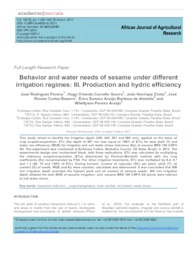Behavior and water needs of sesame under different irrigation regimes: III. Production and hydric efficiency.
Behavior and water needs of sesame under different irrigation regimes: III. Production and hydric efficiency.
Author(s): PEREIRA, J. R.; GUERRA, H. O. C.; ZONTA, J. H.; BEZERRA, J. R. C.; ALMEIDA, E. S. A. B. de; ARAÚJO, W. P.
Summary: This study aimed to identify the irrigation depth (305, 436, 567 and 698 mm), applied on the basis of crop evapotranspiration- ETc (the depth of 567 mm was equal to 100% of ETc) for best yield (Y) and water use efficiency (WUE) for irrigation and soil water stress tolerance (Ky) of sesame BRS 196 CNPA G4. The experiment was conducted at Embrapa Cotton, Barbalha County, CE State, Brazil, in 2012. The experimental design was randomized block, with three replications. ETc was calculated by multiplying the reference evapotranspiration (ETo) determined by Penman-Monteith method with the crop coefficients (Kc) recommended by FAO. For other irrigation treatments, ETc was multiplied by 0.4, 0.7 and 1.3 (40, 70 and 130% of ETc). During harvest, number of capsules (NC) per plant, yield (Y), oil content (O) of seeds, WUE and Ky were counted, calculated and determined. It was concluded that 698 mm irrigation depth provided the highest yield and oil content of sesame seeds; 305 mm irrigation depth allowed the best WUE of sesame irrigation; and, sesame BRS 196 CNPA G4 plants were tolerant to soil water stress.
Publication year: 2017
Types of publication: Journal article
Unit: Embrapa Cotton
Observation
Some of Embrapa's publications are published as ePub files. To read them, use or download one of the following free software options to your computer or mobile device. Android: Google Play Books; IOS: iBooks; Windows and Linux: Calibre.
Access other publications
Access the Agricultural Research Database (BDPA) to consult Embrapa's full library collection and records.
Visit Embrapa Bookstore to purchase books and other publications sold by Embrapa.

